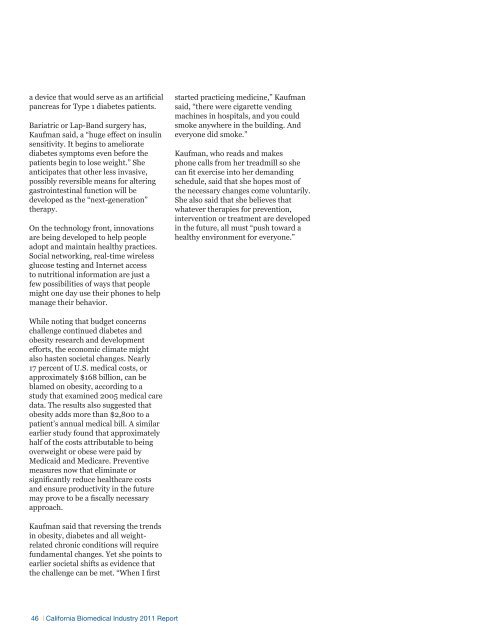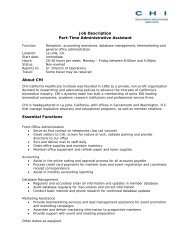California Biomedical Industry - California Healthcare Institute
California Biomedical Industry - California Healthcare Institute
California Biomedical Industry - California Healthcare Institute
You also want an ePaper? Increase the reach of your titles
YUMPU automatically turns print PDFs into web optimized ePapers that Google loves.
a device that would serve as an artificialpancreas for Type 1 diabetes patients.Bariatric or Lap-Band surgery has,Kaufman said, a “huge effect on insulinsensitivity. It begins to amelioratediabetes symptoms even before thepatients begin to lose weight.” Sheanticipates that other less invasive,possibly reversible means for alteringgastrointestinal function will bedeveloped as the “next-generation”therapy.On the technology front, innovationsare being developed to help peopleadopt and maintain healthy practices.Social networking, real-time wirelessglucose testing and Internet accessto nutritional information are just afew possibilities of ways that peoplemight one day use their phones to helpmanage their behavior.started practicing medicine,” Kaufmansaid, “there were cigarette vendingmachines in hospitals, and you couldsmoke anywhere in the building. Andeveryone did smoke.”Kaufman, who reads and makesphone calls from her treadmill so shecan fit exercise into her demandingschedule, said that she hopes most ofthe necessary changes come voluntarily.She also said that she believes thatwhatever therapies for prevention,intervention or treatment are developedin the future, all must “push toward ahealthy environment for everyone.”While noting that budget concernschallenge continued diabetes andobesity research and developmentefforts, the economic climate mightalso hasten societal changes. Nearly17 percent of U.S. medical costs, orapproximately $168 billion, can beblamed on obesity, according to astudy that examined 2005 medical caredata. The results also suggested thatobesity adds more than $2,800 to apatient’s annual medical bill. A similarearlier study found that approximatelyhalf of the costs attributable to beingoverweight or obese were paid byMedicaid and Medicare. Preventivemeasures now that eliminate orsignificantly reduce healthcare costsand ensure productivity in the futuremay prove to be a fiscally necessaryapproach.Kaufman said that reversing the trendsin obesity, diabetes and all weightrelatedchronic conditions will requirefundamental changes. Yet she points toearlier societal shifts as evidence thatthe challenge can be met. “When I first46 | <strong>California</strong> <strong>Biomedical</strong> <strong>Industry</strong> 2011 Report






